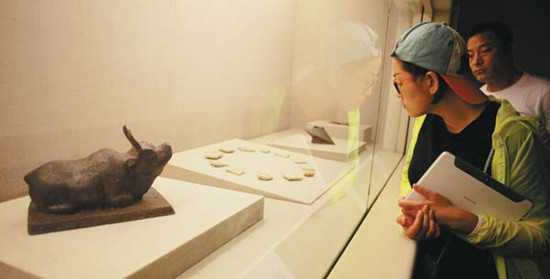
Visitors inspect the rich collection at the Arthur M. Sackler Museum of Art and Archaeology in Peking University. Photos by Wang Jing / China Daily
An archaeology museum endowed to Peking University by a US philanthropist in 1993 is still a world-class facility.
When Song Xiangguang studied archaeology at Peking University in the 1980s, the department was scant on resources, despite the university being the leading archaeology school in China since the 1930s. Song vividly remembers handling ancient ceramics in a dusty classroom that was used as a specimen room, verifying what age they were from in the dim light.
"When I first heard Mr Sackler, an art collector from the United States, was going to endow a museum at our school, I thought, 'Good. They are going to improve the specimen room', but in fact, they built a world-class teaching museum," said Song, now the deputy director of the Arthur M. Sackler Museum of Art and Archaeology at PKU. "More importantly, they brought the advanced idea of archaeology and museology to China. This museum also symbolizes the friendship between the two countries."
In a leafy corner near the West Gate of the PKU campus, the concrete-framed two-story museum with a traditional clay tile gambrel roof harmonizes with the other buildings in the university. Surrounded by a small pond and a classical Chinese garden, the museum is also conspicuous for its polychromed bracketing on the eaves that gleam under the summer sun.
By the museum's front gate is a bronze bust of the late Arthur M. Sackler, a scientist, art collector and the museum's benefactor.
As one of the world's great art collectors and connoisseurs, Sackler collected objects and paintings from various parts of the world and from different periods — from ancient times to the present. He was also a major benefactor to museums, universities and other institutions in the arts, sciences, and humanities. In addition to the Arthur M. Sackler Gallery at the Smithsonian in Washington DC in the US, Sackler endowed several museums worldwide, including a teaching museum at Harvard University.
Sackler's major focus, however, was Chinese art. He once wrote that after discovering some Chinese ceramics and Chinese Ming furniture in 1950, his life was never the same.
"He spotted a small Ming Chinese table in the corner of a store, and he asked where more could be obtained. He was attracted by its subtle and strong lines. He really enjoyed its restrained power and elegance," said Jill Sackler, Sackler's widow, who has been supporting the museum at PKU since her husband passed away in 1987.

Copyright ©1999-2011 Chinanews.com. All rights reserved.
Reproduction in whole or in part without permission is prohibited.